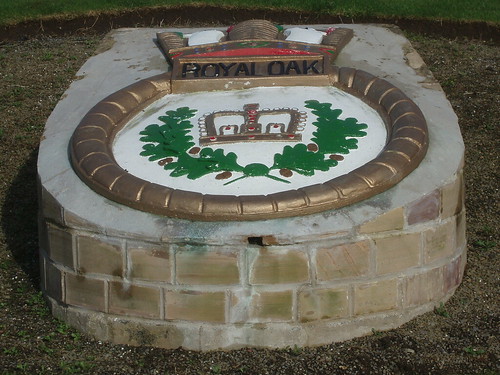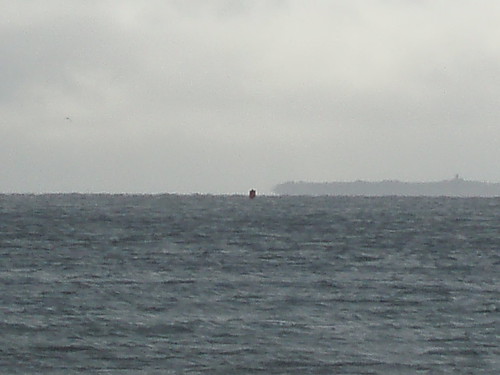View across the Outer Harbour of Stornoway
Saturday, 10 October 2009
Front picture
I have once more changed the picture, heading this blog, to an image I took last Wednesday during a visit to Bosta Beach in Great Bernera. What is littering the beach is seaweed, torn loose in recent gales. The island in the distance is called Old Hill, which can be seen from near the Butt of Lewis, some 35 miles to the northeast.
70 years ago - this Tuesday
On 13 October 1939, the Royal Navy's HMS Royal Oak, at anchor in Scapa Flow, Orkney, was struck by four torpedoes from German submarine U-47. The first torpedo did no major damage when it struck just before 1 am. The last three torpedoes, fired at 1.16 am, proved fatal. Within 13 minutes, Royal Oak turned turtle and went to the bottom, taking 833 crew with her. She currently still lies in 100 feet of water, upside down, reaching 5 metres / 17 feet below the surface of the water. The site is marked by a green wreck buoy and has been marked as a wargrave.
Tomorrow, the 70th anniversary of this tragedy will be remembered in Orkney's main town, Kirkwall. Last year, I visited Orkney and called in at the Royal Oak memorial ashore at Scapa, near the local Coastguard Station. I'll share some of the pictures I took at the time, dedicating this entry to the memory of all those lost there in 1939.



The wreckbuoy
Tomorrow, the 70th anniversary of this tragedy will be remembered in Orkney's main town, Kirkwall. Last year, I visited Orkney and called in at the Royal Oak memorial ashore at Scapa, near the local Coastguard Station. I'll share some of the pictures I took at the time, dedicating this entry to the memory of all those lost there in 1939.



The wreckbuoy
Appeal to those across the pond
I relay an appeal by Dr Jeff Masters, who writes a blog on tropical cyclones (hurricanes etc.). He is warning that a satellite which provides crucial data on forecasting tropical cyclones, QuikSCAT, is about to fail. The satellite measures windspeeds and direction at the earth's surface, and has been in action for 10 years, well beyond its 2-3 year lifespan. If the funding cycle is initiated now, a replacement satellite could be in orbit by 2015. QuikSCAT's data save $135m a year in costs for shipping etc.
If you are in the USA and read this, please take the time to head over to Dr Masters' blog and get in touch with your local Senator to urge them to vote against a senate amendment, which would see a $172m cut in NOAA's budget to be diverted to law enforcement.
Please relay.
If you are in the USA and read this, please take the time to head over to Dr Masters' blog and get in touch with your local Senator to urge them to vote against a senate amendment, which would see a $172m cut in NOAA's budget to be diverted to law enforcement.
Please relay.
Saturday 10 October
Fairly bright in Stornoway this morning, with some drizzle on and off. Some light showers show on the rainfall radar out in the Atlantic. It looks as if our temperatures are on a slow downward slope (what do you expect in autumn).
A search is continuing on the Isle of Skye, south of here, for a man of 83 who has been missing since October 3rd. Clifford Wannop went for a walk in the Kinloch area of Skye, about 6 miles south of Broadford, and has not returned. Mr Wannop, pictured on this BBC link, is described as fit and active for his age, giving the impression of a man in his sixties rather than his eighties. Kinloch is a hilly, wooded area, bordering on the Sound of Sleat, which separates Skye from the Scottish mainland. There are several walking trails in the area, one leading to a deserted village (Leitir Fura), and one other going the 8 miles northeast to Kyle Rhea. Three regional mountain rescue teams will conduct a thorough search today, Saturday.
A northern bottle-nosed whale, which had become stuck in Loch Linnhe near Fort William, has died. A huge rescue effort had been mounted all week to try to coax the cetacean out to the open sea. At one stage, underwater recordings of the sounds of a killer whale were played to try to get the whale to move away. It did not manage to get past the Narrows of Corran, which would have allowed it to proceed to open waters.
A search is continuing on the Isle of Skye, south of here, for a man of 83 who has been missing since October 3rd. Clifford Wannop went for a walk in the Kinloch area of Skye, about 6 miles south of Broadford, and has not returned. Mr Wannop, pictured on this BBC link, is described as fit and active for his age, giving the impression of a man in his sixties rather than his eighties. Kinloch is a hilly, wooded area, bordering on the Sound of Sleat, which separates Skye from the Scottish mainland. There are several walking trails in the area, one leading to a deserted village (Leitir Fura), and one other going the 8 miles northeast to Kyle Rhea. Three regional mountain rescue teams will conduct a thorough search today, Saturday.
A northern bottle-nosed whale, which had become stuck in Loch Linnhe near Fort William, has died. A huge rescue effort had been mounted all week to try to coax the cetacean out to the open sea. At one stage, underwater recordings of the sounds of a killer whale were played to try to get the whale to move away. It did not manage to get past the Narrows of Corran, which would have allowed it to proceed to open waters.
Subscribe to:
Comments (Atom)